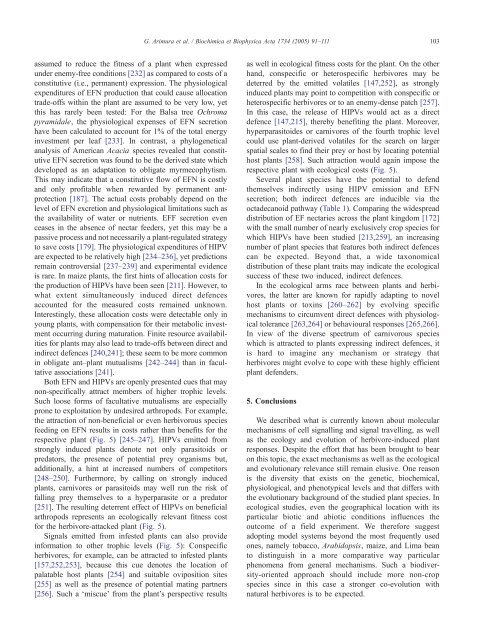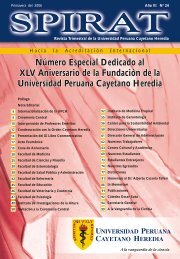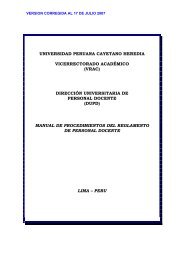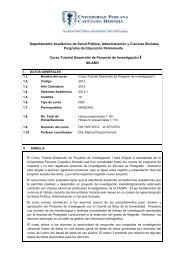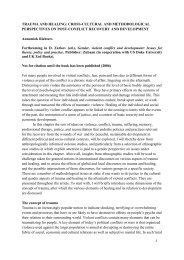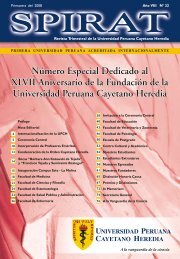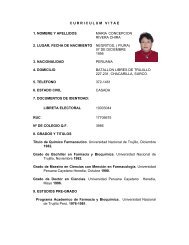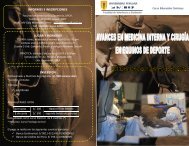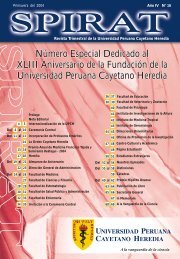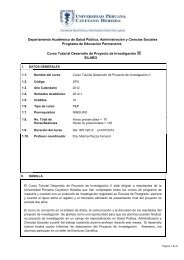Herbivore-induced, indirect plant defences - UPCH
Herbivore-induced, indirect plant defences - UPCH
Herbivore-induced, indirect plant defences - UPCH
Create successful ePaper yourself
Turn your PDF publications into a flip-book with our unique Google optimized e-Paper software.
G. Arimura et al. / Biochimica et Biophysica Acta 1734 (2005) 91–111 103assumed to reduce the fitness of a <strong>plant</strong> when expressedunder enemy-free conditions [232] as compared to costs of aconstitutive (i.e., permanent) expression. The physiologicalexpenditures of EFN production that could cause allocationtrade-offs within the <strong>plant</strong> are assumed to be very low, yetthis has rarely been tested: For the Balsa tree Ochromapyramidale, the physiological expenses of EFN secretionhave been calculated to account for 1% of the total energyinvestment per leaf [233]. In contrast, a phylogeneticalanalysis of American Acacia species revealed that constitutiveEFN secretion was found to be the derived state whichdeveloped as an adaptation to obligate myrmecophytism.This may indicate that a constitutive flow of EFN is costlyand only profitable when rewarded by permanent antprotection[187]. The actual costs probably depend on thelevel of EFN excretion and physiological limitations such asthe availability of water or nutrients. EFF secretion evenceases in the absence of nectar feeders, yet this may be apassive process and not necessarily a <strong>plant</strong>-regulated strategyto save costs [179]. The physiological expenditures of HIPVare expected to be relatively high [234–236], yet predictionsremain controversial [237–239] and experimental evidenceis rare. In maize <strong>plant</strong>s, the first hints of allocation costs forthe production of HIPVs have been seen [211]. However, towhat extent simultaneously <strong>induced</strong> direct <strong>defences</strong>accounted for the measured costs remained unknown.Interestingly, these allocation costs were detectable only inyoung <strong>plant</strong>s, with compensation for their metabolic investmentoccurring during maturation. Finite resource availabilitiesfor <strong>plant</strong>s may also lead to trade-offs between direct and<strong>indirect</strong> <strong>defences</strong> [240,241]; these seem to be more commonin obligate ant–<strong>plant</strong> mutualisms [242–244] than in facultativeassociations [241].Both EFN and HIPVs are openly presented cues that maynon-specifically attract members of higher trophic levels.Such loose forms of facultative mutualisms are especiallyprone to exploitation by undesired arthropods. For example,the attraction of non-beneficial or even herbivorous speciesfeeding on EFN results in costs rather than benefits for therespective <strong>plant</strong> (Fig. 5) [245–247]. HIPVs emitted fromstrongly <strong>induced</strong> <strong>plant</strong>s denote not only parasitoids orpredators, the presence of potential prey organisms but,additionally, a hint at increased numbers of competitors[248–250]. Furthermore, by calling on strongly <strong>induced</strong><strong>plant</strong>s, carnivores or parasitoids may well run the risk offalling prey themselves to a hyperparasite or a predator[251]. The resulting deterrent effect of HIPVs on beneficialarthropods represents an ecologically relevant fitness costfor the herbivore-attacked <strong>plant</strong> (Fig. 5).Signals emitted from infested <strong>plant</strong>s can also provideinformation to other trophic levels (Fig. 5): Conspecificherbivores, for example, can be attracted to infested <strong>plant</strong>s[157,252,253], because this cue denotes the location ofpalatable host <strong>plant</strong>s [254] and suitable oviposition sites[255] as well as the presence of potential mating partners[256]. Such a dmiscueT from the <strong>plant</strong>’s perspective resultsas well in ecological fitness costs for the <strong>plant</strong>. On the otherhand, conspecific or heterospecific herbivores may bedeterred by the emitted volatiles [147,252], as strongly<strong>induced</strong> <strong>plant</strong>s may point to competition with conspecific orheterospecific herbivores or to an enemy-dense patch [257].In this case, the release of HIPVs would act as a directdefence [147,215], thereby benefiting the <strong>plant</strong>. Moreover,hyperparasitoides or carnivores of the fourth trophic levelcould use <strong>plant</strong>-derived volatiles for the search on largerspatial scales to find their prey or host by locating potentialhost <strong>plant</strong>s [258]. Such attraction would again impose therespective <strong>plant</strong> with ecological costs (Fig. 5).Several <strong>plant</strong> species have the potential to defendthemselves <strong>indirect</strong>ly using HIPV emission and EFNsecretion; both <strong>indirect</strong> <strong>defences</strong> are inducible via theoctadecanoid pathway (Table 1). Comparing the widespreaddistribution of EF nectaries across the <strong>plant</strong> kingdom [172]with the small number of nearly exclusively crop species forwhich HIPVs have been studied [213,259], an increasingnumber of <strong>plant</strong> species that features both <strong>indirect</strong> <strong>defences</strong>can be expected. Beyond that, a wide taxonomicaldistribution of these <strong>plant</strong> traits may indicate the ecologicalsuccess of these two <strong>induced</strong>, <strong>indirect</strong> <strong>defences</strong>.In the ecological arms race between <strong>plant</strong>s and herbivores,the latter are known for rapidly adapting to novelhost <strong>plant</strong>s or toxins [260–262] by evolving specificmechanisms to circumvent direct <strong>defences</strong> with physiologicaltolerance [263,264] or behavioural responses [265,266].In view of the diverse spectrum of carnivorous specieswhich is attracted to <strong>plant</strong>s expressing <strong>indirect</strong> <strong>defences</strong>, itis hard to imagine any mechanism or strategy thatherbivores might evolve to cope with these highly efficient<strong>plant</strong> defenders.5. ConclusionsWe described what is currently known about molecularmechanisms of cell signalling and signal travelling, as wellas the ecology and evolution of herbivore-<strong>induced</strong> <strong>plant</strong>responses. Despite the effort that has been brought to bearon this topic, the exact mechanisms as well as the ecologicaland evolutionary relevance still remain elusive. One reasonis the diversity that exists on the genetic, biochemical,physiological, and phenotypical levels and that differs withthe evolutionary background of the studied <strong>plant</strong> species. Inecological studies, even the geographical location with itsparticular biotic and abiotic conditions influences theoutcome of a field experiment. We therefore suggestadopting model systems beyond the most frequently usedones, namely tobacco, Arabidopsis, maize, and Lima beanto distinguish in a more comparative way particularphenomena from general mechanisms. Such a biodiversity-orientedapproach should include more non-cropspecies since in this case a stronger co-evolution withnatural herbivores is to be expected.


